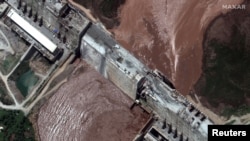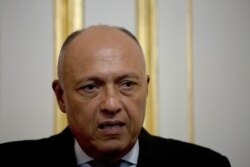Ethiopia's controversial Nile River mega-dam project has hit its first-year filling target, Prime Minister Abiy Ahmed said Wednesday.
The $4.6 billion Grand Ethiopian Renaissance Dam (GERD) will be the largest in Africa. When it reaches full power-generating capacity in 2023, it is expected to generate 6,000 megawatts of electricity.
"We have successfully completed the first dam filling without bothering and hurting anyone else. Now, the dam is overflowing downstream," Ahmed said in a statement.
The announcement came a day after leaders from Ethiopia, Egypt and Sudan met in a virtual summit and agreed to resume talks on the controversial dam.
It is unclear if the filling is due purely to rainy season precipitation or if filling operations are also being conducted.
Ethiopia started construction on the dam, located on the Nile's biggest tributary, in 2011. After nearly a decade of talks, little has been done to resolve the dispute between the three countries.
Ethiopia plans to sell some of the new, cheap electricity to neighbors alongside the domestic electricity provision, and views the dam as a ticket to economic growth. The downstream nations of Egypt and Sudan fear that the dam will limit their access to crucial Nile freshwater.
At the United Nations in June, Egyptian Foreign Minister Sameh Shoukry called the dam "a threat of potentially existential proportions." Although the country maintains massive reserves behind its own Nile dam at Aswan, it ultimately relies on the Nile for nearly 90% of its water.
Egypt will prioritize "reaching a binding legal agreement on the rules of the filling and operation of the GERD," said a presidential press release Tuesday. So far, Ethiopia has refused to agree to a binding deal.
Ethiopia previously said that the first-year target was 4.9 billion cubic meters of water, the height of the lowest point on the dam wall. The dam and reservoir have a total capacity of 74 billion cubic meters.
"The construction of the dam and the filling of the water go hand in hand," Ethiopian Water Minister Seleshi Bekele said in televised comments this week.
Tuesday's decision to continue talks was made during an African Union meeting. Previous sessions have failed to produce agreement on the dam. A U.S. mediation attempt in February this year was also unsuccessful.












